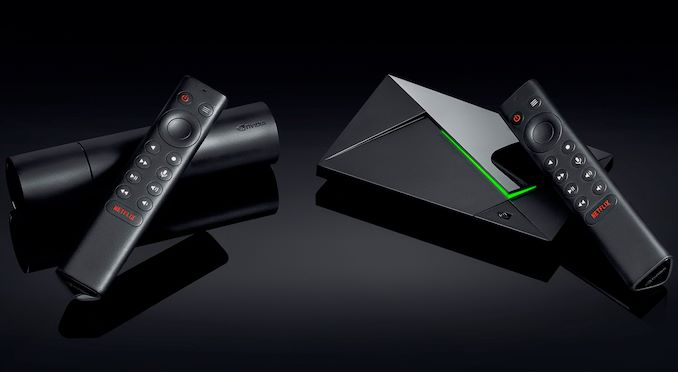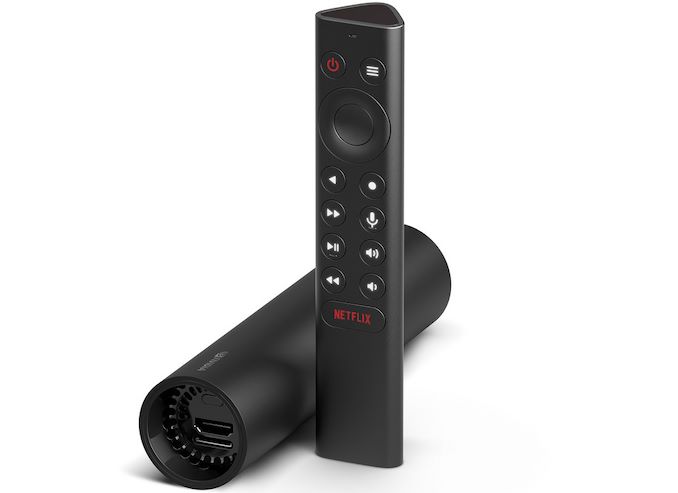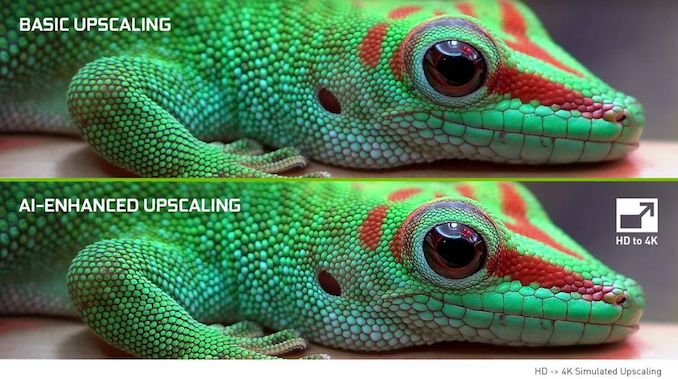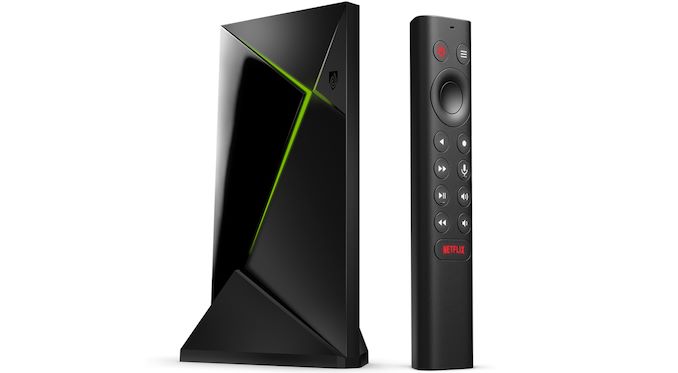NVIDIA Reveals New SHIELD TV: Tegra X1+, Dolby Vision, Dolby Atmos
by Anton Shilov on October 29, 2019 11:00 AM EST
NVIDIA has introduced new versions of its SHIELD TV set-top-boxes featuring an all-new design as well as based on an improved Tegra X1+ SoC. The new STBs support all the features its predecessors do and add support for Dolby Vision HDR, Dolby Atmos audio, as well as a new AI-powered upscale algorithm. With the launch of the new devices NVIDIA somewhat changes concept of its STBs as they no longer come with a gamepad.
The new NVIDIA SHIELD TV devices use the company’s new Tegra X1+ SoC that is said to be 25% faster when compared to the original one launched over four years ago. The chip essentially has the same feature set and Maxwell graphics, so games developed with the original SoC in mind will work with the new one without any problems. Meanwhile, since the Tegra X1+ is made using a more advanced process technology, this allows NVIDIA to offer the new SHIELD TV in a more compact form-factor. At the same time, the new SoC is paired with 2 GB of RAM (down from 3 GB) as well as 8 GB of NAND flash storage (down from 16 GB previously), which can be expanded using a microSD card. The SHIELD Pro has 3 GB of RAM as well as 16 GB of NAND storage, but no longer has a hard drive.
NVIDIA made its new SHIELD TV smaller than the predecessor in a bid to better compete against compact streaming media device, such as Google’s Chromecast/Chromecast Ultra. From connectivity standpoint, the new STB features Wi-Fi 5, Bluetooth 5.0, a GbE port, an HDMI 2.0b output with HDCP 2.2, and a microSD card slot. Meanwhile, it no longer has USB 3.0 ports, possibly to save space and simplify design. Those who need USB 3.0 should buy the SHIELD Pro with two USB Type-A ports.
| NVIDIA SHIELD STB Family | ||||||
| SHIELD TV (2019) |
SHIELD TV Pro (2019) |
SHIELD TV (2017) |
SHIELD TV Pro (2017) |
SHIELD Android TV (2015) |
||
| SoC | Tegra X1+ | Tegra X1 (4 × Cortex A57 + 4 × Cortex A53, Maxwell 2 SMM GPU) |
||||
| RAM | 2 GB | 3 GB | 3 GB LPDDR4-3200 | |||
| Storage | 8 GB NAND microSD |
16 GB NAND USB |
16 GB NAND USB |
16 GB NAND 500 GB HDD microSD USB |
16 GB NAND 500 GB HDD (Pro only) microSD USB |
|
| Display Connectivity | HDMI 2.0b with HDCP 2.2 (4Kp60, HDR) | |||||
| Dimensions | Height | 40 mm 1.57 inch |
98 mm 3.858 inch |
130 mm 5.1 inch |
||
| Width | 40mm 1.57 inch |
159 mm 6.26 inch |
210 mm 8.3 inch |
|||
| Depth | 165 mm 6.5 inch |
26 mm 1.02 inch |
25 mm 1 inch |
|||
| Weight | 137 grams | 250 grams | 654 grams | |||
| Power Adapter | integrated | ? | 40 W | |||
| I/O | Wireless | 2x2 802.11a/b/g/n/ac Bluetooth 4.1/BLE |
||||
| USB | - | 2 × USB 3.0 | 2 × USB 3.0 1 × micro-USB 2.0 |
|||
| IR | - | - | - | IR Receiver | ||
| Ethernet | Gigabit Ethernet | |||||
| Launch Product Bundle | Shield Remote | Shield Controller Shield Remote |
Shield Controller | |||
| Launch Price | $149.99 | $199.99 | $199.99 | $299.99 | Basic: $199.99 Pro: $299.99 |
|
When it comes to decoding capabilities, the new SHIELD TV can decode H.265/HEVC, VP8, VP9, H.264, MPEG1/2, H.263, MJPEG, MPEG4, and WMV9/VC1 video. Meanwhile, the STB does not support AV1 as well as VP9.2 codecs because they are not widespread at the moment. The new SHIELD TV can playback 4Kp60 HDR, 4Kp60, Full-HD 60 fps content, and can upscale 720p and 1080p content to 4Kp30 using an AI-enhanced algorithm. It is unclear whether the algorithm relies on a new hardware block that is present only inside NVIDIA’s Tegra X1+, or uses a combination of hardware and software, which means that it could be enabled on previous-generation SHIELD TV consoles too
| NVIDIA's 2019 SHIELD TV STBs | |||
| Video | |||
| 4K HDR at 60 FPS | H.265/HEVC | ||
| 4K at 60 FPS | VP8, VP9, H.264, MPEG1/2 | ||
| 1080p at 60 FPS | H.263, MJPEG, MPEG4, WMV9/VC1 | ||
| HDR | HDR10, Dolby Vision | ||
| Containers | Xvid/ DivX/ASF/AVI/MKV/MOV/M2TS/MPEG-TS/MP4/WEB-M | ||
| Audio | |||
| Audio Support | AAC, AAC+, eAAC+, MP3, WAVE, AMR, OGG Vorbis, FLAC, PCM, WMA, WMA-Pro, WMA-Lossless, Dolby Digital Plus, Dolby Atmos, Dolby TrueHD (pass-through), DTS-X (pass-through), and DTS-HD (pass-through) | ||
| High-Resolution Audio Playback | up to 24-bit/192 kHz over HDMI and USB | ||
| High-Resolution Audio Upsample | up to 24-bit/192 kHz over USB | ||
The new SHIELD TV STBs come with a redesigned SHIELD remote with improved ergonomics and more buttons. The unit has a built-in microphone for Google Assistant and Amazon Alexa; motion-activated backlit buttons; Bluetooth connectivity to connect to the player; and an IR blaster to control volume and power on TVs, soundbars or receivers.
Being based on Android TV/Android 9.0 (Pie) platform, the SHIELD TV ships with a variety of content deliver apps, including Netflix, YouTube, Amazon Prime Video, Amazon Music, Vudu, Google Play Movies & TV, Plex, Google Play Games, NVIDIA Games, and Google Games. End-users may install additional apps themselves if they need to.
Because of the simplified design and the lack of bundled gamepad, the new NVIDIA SHIELD TV media players are cheaper than their predecessors: the base model costs $149.99 (down from $199.99), whereas the Pro model is priced at $199.99 (down from $299.00).
Related Reading:
- SHIELD TV Now Supports 120 Hz Refresh, Ups Wi-Fi Bandwidth for GeForce NOW
- NVIDIA Unifies GeForce NOW Service Across PCs and SHIELD TV STBs: 200+ Games Supported
- NVIDIA Temporarily Slashes $30 Off the SHIELD TV: Now Staring at $149
- NVIDIA Releases Android 7.0 Update for 2015 SHIELD TV, Adds Amazon Video App
- NVIDIA Launches SHIELD TV: Smart Home Functionality, More 4K HDR Streaming Services
- NVIDIA SHIELD Android TV Console Adds Support for Vudu, HDR and 4Kp60 Content
Source: NVIDIA













80 Comments
View All Comments
haukionkannel - Tuesday, October 29, 2019 - link
Apple tv is Many times more powerfull than shield...but all in all it depends on what platform you Are going to use...
In feature wise shield has the same advantage as with all Android devices. A lot of apps...
Apple has less, but there Are Also less those really badly made apps...
Alistair - Tuesday, October 29, 2019 - link
Basically I have a programmer friend and he loves to tinker with his Shield, and Apple's product is annoying locked down in comparison, but that doesn't change the hardware is slow and outdated, and yet still expensive. nVidia in a holding pattern until it is discontinued.Beaver M. - Wednesday, October 30, 2019 - link
Exactly. You simply dont buy Apple when you want a more open architecture. I mean just their Bluetooth hassle is just not worth it.Alistair - Tuesday, October 29, 2019 - link
Except you're completely wrong. The nVidia Shield uses the same CPU core as the Note 4, from 2014, the Cortex A57, 5 years old. The Apple 4K TV's CPU is much stronger. And the GPU is good in the Shield, but is basically an iPhone 8 level GPU, also not any faster than the Apple TV which uses the A10X.It was an ambitious product when it released 4 years ago, but is mediocre today. The $35 Raspberry Pi has a faster CPU... that's how bad it is. It is a TV setup box and its improvements are software only, but the hardware is nothing special 5 years later.
jordanclock - Tuesday, October 29, 2019 - link
The AppleTV does have better hardware, but I think it's a HUUUGE stretch to say the Raspberry Pi 3B+ has a better CPU. The Pi 3B+ uses quad A53 cores, the Shield has quad A57 cores. That gives the Shield superscalar and out-of-order instructions.The Shield also has a great GPU, though it is less impressive today than when it launched.
I'm pretty sure Nintendo wouldn't have used the Tegra X1 if it's CPU was no better than a Pi 3B+.
SarahKerrigan - Tuesday, October 29, 2019 - link
Nobody said 3B+, which is not the current model. The Raspberry Pi 4 uses a quad A72 processor.BenSkywalker - Tuesday, October 29, 2019 - link
A8X vs Tegra X1?https://www.anandtech.com/show/8811/nvidia-tegra-x...
Some mighty strong kool aid to try and pretend those are close.
Let's step up to the A11
https://benchmarks.ul.com/hardware/phone/Apple+iPh...
https://benchmarks.ul.com/hardware/tablet/NVIDIA+S...
Apple's 'great' GPUs for mobile are a silly rumor because they get compared to Qualcomms garbage. That's the A11 losing to a four year old nVidia mobile GPU.
Alistair - Tuesday, October 29, 2019 - link
why are you ranting about the wrong cpu and gpu? why don't you actually look it up next time? the apple TV uses the GPU focused iPad Pro cpu, the A10X...BenSkywalker - Tuesday, October 29, 2019 - link
Why don't you look up, literally, anything?https://www.apple.com/apple-tv-hd/specs/
A8, I showed A8x and A11 benches, both of which showed Shield is clearly superior despite your absurdly dishonest claims that the A8 was comparable.
Was that a flat out lie or are you that ignorant on the subject?
So you seem to be trying to change to a discussion about the Apple TV 4k. If that is the case, you need to specify. A Mac and a Mac, which one is faster? The i or Pro matter.
name99 - Tuesday, October 29, 2019 - link
Apple currently sells two Apple TVs.The cheaper one is based on the A8, The more expensive (4K) one is based on the A10X.
https://www.apple.com/apple-tv-4k/specs/
It is LIKELY, based on previous history (though who knows for sure) that at some point soon (this year?) Apple will release an even newer version based on the A12.
As for benchmarks, especially GPU benchmarks, I don't know what to tell you.
I have no idea what the site benchmarks.ul.com does, but their benchmark numbers for the iPhone 11 seem completely unrelated to what AnandTech reported, and I'd trust AnandTech a lot more.
(AnandTech shows numbers for both cooled and uncooled GPU. Cooled is more relevant to aTV because it has a fan and is physically larger than iPhone.)
Another imperfect benchmark for GPUs is GeekBench Compute, but at least it's cross platform and has a large database.
The Summary number there for the iPad Pro (ie A10X) is 32000.
(For iPhone the appropriate number is about 10000).
The best Summary number there I could find for Shield is a value from late 2017, of 20000.
Presumably this new device has a better GPU. Is it 1.6x better? No idea.
So yeah, it looks like old Shield is 2x better (at least for GPU compute) than old aTV, but 1.6 worse than the newer 4K aTV.
New Shield numbers? I guess we'll see when it's in users' hands.